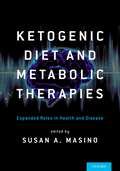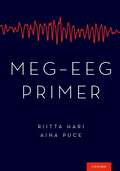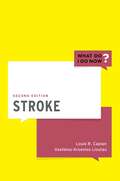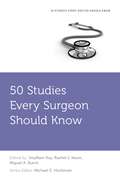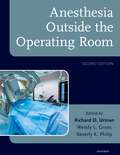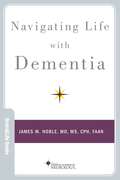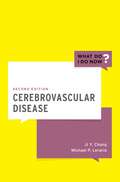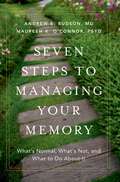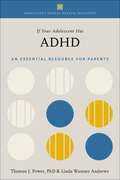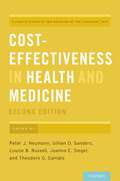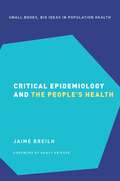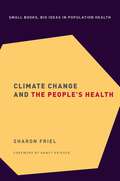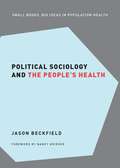- Table View
- List View
Ketogenic Diet and Metabolic Therapies: Expanded Roles in Health and Disease
Ketogenic diets have been used to successfully treat epilepsy and stop seizures for nearly a century. When more traditional therapies, such as pharmacology, reach their limitations for treatment, the metabolic approach surpasses, targeting the overall physiology and homeostatic functions of the patient. Ketogenic Diet and Metabolic Therapies is the first comprehensive scientific resource on the ketogenic diet, covering the latest research including the biomedical mechanisms, established and emerging applications, metabolic alternatives, and implications for health and disease. Experts in clinical and basic research share their research into mechanisms spanning from ion channels to epigenetics, their insights based on decades of experience with the ketogenic diet in epilepsy, and their evidence for emerging applications ranging from autism to Alzheimer's disease to brain cancer. Research in metabolic therapies has spread into laboratories and clinics of every discipline, and is yielding to entirely new classes of drugs and treatment regimens. The book's editor, Susan A. Masino, brings her unique expertise in clinical and research neurology to the overall scope of this work. To further enhance the scope and quality of this one of a kind book, section editors Eric Kossoff, Jong Rho, Detlev Boison, and Dominic P. D'Agostino lend their oversight on their respective sections.
MEG-EEG Primer
by Aina Puce Riitta HariMagnetoencephalography (MEG) and electroencephalography (EEG) provide complementary views to the neurodynamics of healthy and diseased human brains. Both methods are totally noninvasive and can track with millisecond temporal resolution spontaneous brain activity, evoked responses to various sensory stimuli, as well as signals associated with the performance of motor, cognitive and affective tasks. MEG records the magnetic fields, and EEG the potentials associated with the same neuronal currents, which however are differentially weighted due to the physical and physiological differences between the methods. MEG is rather selective to activity in the walls of cortical folds, whereas EEG senses currents from the cortex (and brain) more widely, making it harder to pinpoint the locations of the source currents in the brain. Another important difference between the methods is that skull and scalp dampen and smear EEG signals, but do not affect MEG. Hence, to fully understand brain function, information from MEG and EEG should be combined. Additionally, the excellent neurodynamical information these two methods provide can be merged with data from other brain-imaging methods, especially functional magnetic resonance imaging where spatial resolution is a major strength. MEG-EEG Primer is the first-ever volume to introduce and discuss MEG and EEG in a balanced manner side-by-side, starting from their physical and physiological bases and then advancing to methods of data acquisition, analysis, visualization, and interpretation. The authors pay special attention to careful experimentation, guiding readers to differentiate brain signals from various artifacts and to assure that the collected data are reliable. The book weighs the strengths and weaknesses of MEG and EEG relative to one another and to other methods used in systems, cognitive, and social neuroscience. The authors also discuss the role of MEG and EEG in the assessment of brain function in various clinical disorders. The book aims to bring members of multidisciplinary research teams onto equal footing so that they can contribute to different aspects of MEG and EEG research and to be able to participate in future developments in the field.
MEG-EEG Primer
by Riitta Hari Aina PuceMagnetoencephalography (MEG) and electroencephalography (EEG) provide complementary views to the neurodynamics of healthy and diseased human brains. Both methods are totally noninvasive and can track with millisecond temporal resolution spontaneous brain activity, evoked responses to various sensory stimuli, as well as signals associated with the performance of motor, cognitive and affective tasks. MEG records the magnetic fields, and EEG the potentials associated with the same neuronal currents, which however are differentially weighted due to the physical and physiological differences between the methods. MEG is rather selective to activity in the walls of cortical folds, whereas EEG senses currents from the cortex (and brain) more widely, making it harder to pinpoint the locations of the source currents in the brain. Another important difference between the methods is that skull and scalp dampen and smear EEG signals, but do not affect MEG. Hence, to fully understand brain function, information from MEG and EEG should be combined. Additionally, the excellent neurodynamical information these two methods provide can be merged with data from other brain-imaging methods, especially functional magnetic resonance imaging where spatial resolution is a major strength. MEG-EEG Primer is the first-ever volume to introduce and discuss MEG and EEG in a balanced manner side-by-side, starting from their physical and physiological bases and then advancing to methods of data acquisition, analysis, visualization, and interpretation. The authors pay special attention to careful experimentation, guiding readers to differentiate brain signals from various artifacts and to assure that the collected data are reliable. The book weighs the strengths and weaknesses of MEG and EEG relative to one another and to other methods used in systems, cognitive, and social neuroscience. The authors also discuss the role of MEG and EEG in the assessment of brain function in various clinical disorders. The book aims to bring members of multidisciplinary research teams onto equal footing so that they can contribute to different aspects of MEG and EEG research and to be able to participate in future developments in the field.
Stroke (What Do I Do Now)
by Louis R. Caplan Vasileios LioutasPart of the "What Do I Do Now?" series, Stroke uses a case-based approach to cover common and important topics in the diagnosis and treatment of stroke. Each chapter provides an overview of the approach to the problem in question followed by a discussion of the diagnosis, key points to remember, and selected references for further reading. For this edition, all cases have been carefully revised, and new information and references have been added. Stroke is an engaging collection of thought-provoking cases which clinicians can utilize when they encounter difficult patients on the ward or in the clinic. The volume is also a self-assessment tool that tests the reader's ability to answer the question, "What do I do now?"
Stroke (What Do I Do Now)
by Louis R. Caplan Vasileios LioutasPart of the "What Do I Do Now?" series, Stroke uses a case-based approach to cover common and important topics in the diagnosis and treatment of stroke. Each chapter provides an overview of the approach to the problem in question followed by a discussion of the diagnosis, key points to remember, and selected references for further reading. For this edition, all cases have been carefully revised, and new information and references have been added. Stroke is an engaging collection of thought-provoking cases which clinicians can utilize when they encounter difficult patients on the ward or in the clinic. The volume is also a self-assessment tool that tests the reader's ability to answer the question, "What do I do now?"
50 Studies Every Surgeon Should Know (Fifty Studies Every Doctor Should Know)
by Sreyram Kuy, MD, MHS, FACS Rachel J. Kwon Miguel A. Burch , MD, FACS Michael E. Hochman, MD, MPH50 Studies Every Surgeon Should Know presents key studies that have shaped the practice of surgery. Selected using a rigorous methodology, the studies cover topics including: vascular, colorectal, bariatric, abdominal, hernial, and endocrine surgery, surgical outcomes, surgical oncology, trauma and surgical critical care, and studies of historical interest. For each study, a concise summary is presented with an emphasis on the results and limitations of the study, and its implications for practice. An illustrative clinical case concludes each review, followed by brief information on other relevant studies. This book is a must-read for health care professionals and anyone who wants to learn more about the data behind clinical practice.
Anesthesia Outside the Operating Room
by Richard D. Urman, Wendy L. Gross and Beverly K. PhilipAnesthesia Outside of the Operating Room is a comprehensive, up-to-date textbook that covers all aspects of anesthesia care in OOR settings, from financial considerations to anesthetic techniques to quality assurance. With increasing numbers of procedures such as cardiac catheterization and imaging taking place outside of the main OR, anesthesia providers as well as non-anesthesia members of the patient care team will find this book critical to their understanding of the principles of anesthesia care in unique settings which may have limited physical resources. The book includes chapters on patient monitoring techniques, pre-procedure evaluation and post-procedure care, and procedural sedation performed by non-anesthesia providers. Its authors address problems of anesthesia that have unique answers in OOR settings, such as patient transport and cardiac arrest, and discuss technological progress and considerations for the future. The text also covers surgical procedures and anesthetic considerations by procedure location, such as radiology, infertility clinics, field and military environments, and pediatric settings, among many others Select guidelines from the American Society of Anesthesiologists (ASA) are provided as well. Edited by the senior faculty from Harvard Medical School and with contributions from other academic institutions, Anesthesia Outside of the Operating Room provides a unique and convenient compendium of expertise and experience.
Anesthesia Outside the Operating Room
Anesthesia Outside of the Operating Room is a comprehensive, up-to-date textbook that covers all aspects of anesthesia care in OOR settings, from financial considerations to anesthetic techniques to quality assurance. With increasing numbers of procedures such as cardiac catheterization and imaging taking place outside of the main OR, anesthesia providers as well as non-anesthesia members of the patient care team will find this book critical to their understanding of the principles of anesthesia care in unique settings which may have limited physical resources. The book includes chapters on patient monitoring techniques, pre-procedure evaluation and post-procedure care, and procedural sedation performed by non-anesthesia providers. Its authors address problems of anesthesia that have unique answers in OOR settings, such as patient transport and cardiac arrest, and discuss technological progress and considerations for the future. The text also covers surgical procedures and anesthetic considerations by procedure location, such as radiology, infertility clinics, field and military environments, and pediatric settings, among many others Select guidelines from the American Society of Anesthesiologists (ASA) are provided as well. Edited by the senior faculty from Harvard Medical School and with contributions from other academic institutions, Anesthesia Outside of the Operating Room provides a unique and convenient compendium of expertise and experience.
Navigating Life with Dementia (Brain and Life Books)
by James M. NobleCaregiving for a loved one with Alzheimer's disease or dementia is hard but with this book, you and your family will successfully face the challenges that these diseases present. Dementia is a very common neurological disease of aging affecting millions of people in complex ways. There are multiple forms of the dementia, including Alzheimer's Disease, Lewy Body Dementia, Frontotemporal Dementia, and vascular dementia, among others, and many share features of slowly progressive and profound changes affecting memory, thinking, behavior, and personality. The disease often introduces personal and even financial strains, which can be at times hard to understand. Unfortunately, most forms of dementia have no definitive treatments to prevent, slow, or stop the progression, but there is a concerted effort in the scientific community to change this. There is a consistent hope that there will soon be a new era of scientific breakthroughs impacting dementia. Now, and in the future, patients with dementia, their friends, and their families need resources to successfully face the challenges introduced by the disease. Navigating Life with Dementia is designed as a handbook including tools to manage both day-to-day issues and to anticipate the long-term impact of the disease for dementia patients as well as their friends and families. This volume will help families in all stages of dementia care, beginning with the earliest hints of cognitive problems through advanced stages. In easily understood language, the book thoroughly covers the complexities of the dementias, the establishment of a diagnosis, what to expect throughout the stages of disease, and how to best anticipate and manage common problems.
Navigating Life with Dementia (Brain and Life Books)
by James M. NobleCaregiving for a loved one with Alzheimer's disease or dementia is hard but with this book, you and your family will successfully face the challenges that these diseases present. Dementia is a very common neurological disease of aging affecting millions of people in complex ways. There are multiple forms of the dementia, including Alzheimer's Disease, Lewy Body Dementia, Frontotemporal Dementia, and vascular dementia, among others, and many share features of slowly progressive and profound changes affecting memory, thinking, behavior, and personality. The disease often introduces personal and even financial strains, which can be at times hard to understand. Unfortunately, most forms of dementia have no definitive treatments to prevent, slow, or stop the progression, but there is a concerted effort in the scientific community to change this. There is a consistent hope that there will soon be a new era of scientific breakthroughs impacting dementia. Now, and in the future, patients with dementia, their friends, and their families need resources to successfully face the challenges introduced by the disease. Navigating Life with Dementia is designed as a handbook including tools to manage both day-to-day issues and to anticipate the long-term impact of the disease for dementia patients as well as their friends and families. This volume will help families in all stages of dementia care, beginning with the earliest hints of cognitive problems through advanced stages. In easily understood language, the book thoroughly covers the complexities of the dementias, the establishment of a diagnosis, what to expect throughout the stages of disease, and how to best anticipate and manage common problems.
Cerebrovascular Disease (What Do I Do Now)
by Ji Y. Chong Michael P. LerarioPart of the "What Do I Do Now?" series, Cerebrovascular Disease a case-based approach to cover common and important topics in the examination, investigation, and management of stroke, embolism, thrombosis, hemorrhage, and other critical presentations of cerebrovascular disease. Each chapter provides a discussion of the diagnosis, key points to remember, and selected references for further reading. For this edition, all cases and references have been updated and new cases have been added including: Ischemic stroke in cancer, posterior reversible encephalopathy syndrome (PRES), primary angiitis of the central nervous system, symptomatic spinal vascular malformation, anoxic brain injury, and vascular dementia. Cerebrovascular Disease is an engaging collection of thought-provoking cases which clinicians can utilize when they encounter difficult patients. The volume is also a self-assessment tool that tests the reader's ability to answer the question, "What do I do now?"
Cerebrovascular Disease (What Do I Do Now)
by Ji Y. Chong Michael P. LerarioPart of the "What Do I Do Now?" series, Cerebrovascular Disease a case-based approach to cover common and important topics in the examination, investigation, and management of stroke, embolism, thrombosis, hemorrhage, and other critical presentations of cerebrovascular disease. Each chapter provides a discussion of the diagnosis, key points to remember, and selected references for further reading. For this edition, all cases and references have been updated and new cases have been added including: Ischemic stroke in cancer, posterior reversible encephalopathy syndrome (PRES), primary angiitis of the central nervous system, symptomatic spinal vascular malformation, anoxic brain injury, and vascular dementia. Cerebrovascular Disease is an engaging collection of thought-provoking cases which clinicians can utilize when they encounter difficult patients. The volume is also a self-assessment tool that tests the reader's ability to answer the question, "What do I do now?"
Seven Steps to Managing Your Memory: What's Normal, What's Not, and What to Do About It
by Andrew E. Budson Maureen K. O'ConnorAs you age, you may find yourself worrying about your memory. Where did I put those car keys? What time was my appointment? What was her name again? With more than 41 million Americans over the age of 65 in the United States, the question becomes how much (or, perhaps, what type) of memory loss is to be expected as one gets older and what should trigger a visit to the doctor. Seven Steps to Managing Your Memory addresses these key concerns and more, such as... · What are the signs that suggest your memory problems are more than just part of normal aging? · Is it normal to have concerns about your memory? · What are the markers of mild cognitive impairment, dementia, Alzheimer's, and other neurodegenerative diseases? · How should you convey your memory concerns to your doctor? · What can your doctor do to evaluate your memory? · Which healthcare professional(s) should you see? · What medicines, alternative therapies, diets, and exercises are available to improve your memory? · Can crossword puzzles, computer brain-training games, memory aids, and strategies help strengthen your memory? · What other resources are available when dealing with memory loss? Seven Steps to Managing Your Memory is written in an easy-to-read yet comprehensive style, featuring clinical vignettes and character-based stories that provide real-life examples of how to successfully manage age-related memory loss.
Seven Steps to Managing Your Memory: What's Normal, What's Not, and What to Do About It
by Andrew E. Budson Maureen K. O'ConnorAs you age, you may find yourself worrying about your memory. Where did I put those car keys? What time was my appointment? What was her name again? With more than 41 million Americans over the age of 65 in the United States, the question becomes how much (or, perhaps, what type) of memory loss is to be expected as one gets older and what should trigger a visit to the doctor. Seven Steps to Managing Your Memory addresses these key concerns and more, such as... · What are the signs that suggest your memory problems are more than just part of normal aging? · Is it normal to have concerns about your memory? · What are the markers of mild cognitive impairment, dementia, Alzheimer's, and other neurodegenerative diseases? · How should you convey your memory concerns to your doctor? · What can your doctor do to evaluate your memory? · Which healthcare professional(s) should you see? · What medicines, alternative therapies, diets, and exercises are available to improve your memory? · Can crossword puzzles, computer brain-training games, memory aids, and strategies help strengthen your memory? · What other resources are available when dealing with memory loss? Seven Steps to Managing Your Memory is written in an easy-to-read yet comprehensive style, featuring clinical vignettes and character-based stories that provide real-life examples of how to successfully manage age-related memory loss.
IF YOUR ADOLESCENT HAS ADHD AMHI C: An Essential Resource for Parents (Adolescent Mental Health Initiative)
by Linda Wasmer Andrews Dr. Thomas J. PowerAdolescents (ages 12-20) with attention-deficit/hyperactivity disorder (ADHD) are at risk for academic problems, strained relationships, peer rejection and unsafe behavior -- and parents are often at a loss for how to handle these challenges. If Your Adolescent Has ADHD: An Essential Resource for Parents provides the up-to-date information and down-to-earth support that parents need. It offers an in-depth look at causes, symptoms, diagnosis, treatment, and parenting strategies. Contrary to what was once believed, ADHD that starts earlier in childhood usually persists into the teen years. Yet even experienced parents are often caught unawares by the fresh challenges that adolescence brings. This book is one of the few to address ADHD in the context of teen friendships, dating, curfews and sports and extracurricular activities. It also offers practical advice from a leading psychologist on determining readiness to drive and instilling good homework and study habits. This book is a readable, reliable guide to evidence-based treatments for ADHD including behavioral therapy, medications, and educational interventions. Some approaches, such as school-based mentoring, have been little discussed in other parenting books. The authors also offer effective behavioral strategies that can be used at home, including communication and negotiation, problem solving, rewards, strategic punishments and behavioral contracts; and advice for older adolescents on dealing with college, work, and moving away from home.
If Your Adolescent Has ADHD: An Essential Resource for Parents (Adolescent Mental Health Initiative)
by Dr. Thomas J. Power Linda Wasmer AndrewsAdolescents (ages 12-20) with attention-deficit/hyperactivity disorder (ADHD) are at risk for academic problems, strained relationships, peer rejection and unsafe behavior -- and parents are often at a loss for how to handle these challenges. If Your Adolescent Has ADHD: An Essential Resource for Parents provides the up-to-date information and down-to-earth support that parents need. It offers an in-depth look at causes, symptoms, diagnosis, treatment, and parenting strategies. Contrary to what was once believed, ADHD that starts earlier in childhood usually persists into the teen years. Yet even experienced parents are often caught unawares by the fresh challenges that adolescence brings. This book is one of the few to address ADHD in the context of teen friendships, dating, curfews and sports and extracurricular activities. It also offers practical advice from a leading psychologist on determining readiness to drive and instilling good homework and study habits. This book is a readable, reliable guide to evidence-based treatments for ADHD including behavioral therapy, medications, and educational interventions. Some approaches, such as school-based mentoring, have been little discussed in other parenting books. The authors also offer effective behavioral strategies that can be used at home, including communication and negotiation, problem solving, rewards, strategic punishments and behavioral contracts; and advice for older adolescents on dealing with college, work, and moving away from home.
The Right To Be Loved
by S. Matthew LiaoS. Matthew Liao argues here that children have a right to be loved. To do so he investigates questions such as whether children are rightholders; what grounds a child's right to beloved; whether love is an appropriate object of a right; and other philosophical and practical issues. His proposal is that all human beings have rights to the fundamental conditions for pursuing a good life; therefore, as human beings, children have human rights to the fundamental conditions for pursuing a good life. Since being loved is one of those fundamental conditions, children thus have a right to be loved. Liao shows that this claim need not be merely empty rhetoric, and that the arguments for this right can hang together as a coherent whole. This is the first book to make a sustained philosophical case for the right of children to be loved. It makes a unique contribution to the fast-growing literature on family ethics, in particular, on children's rights and parental rights and responsibilities, and to the emerging field of the philosophy of human rights.
Cost-Effectiveness in Health and Medicine
by Peter J. Neumann, Gillian D. Sanders, Louise B. Russell, Joanna E. Siegel and Theodore G. GaniatsA COMPLETE UPDATE AND REVISION OF THE CLASSIC TEXT "At last, a manual of operations for comparing the cost-effectiveness of a preventive service with a treatment intervention." --American Journal of Preventive Medicine Twenty years after the first edition of COST-EFFECTIVENESS IN HEALTH AND MEDICINE established the practical benchmark for cost-effectiveness analysis, this completely revised edition of the classic text provides an essential resource to a new generation of practitioners, students, researchers, and policymakers. Produced by the Second Panel on Cost-Effectiveness in Health and Medicine--a team of 13 experts from fields including decision science, economics, ethics, psychology, and medicine--this new edition is a comprehensive guide to the use of cost-effectiveness analysis as an evaluative tool at the institutional and policy levels. As health care systems face increasing pressure to derive maximum value from expenditures, the guidelines in this new text represent not just the best information available, but a vital guide to health care decision-making in a challenging new era. Completely revised and enriched with examples and expanded coverage, this second edition of COST-EFFECTIVENESS IN HEALTH AND MEDICINE builds on its predecessor's excellence, offering required reading for both analysts and decision makers.
Cost-Effectiveness in Health and Medicine
A COMPLETE UPDATE AND REVISION OF THE CLASSIC TEXT "At last, a manual of operations for comparing the cost-effectiveness of a preventive service with a treatment intervention." --American Journal of Preventive Medicine Twenty years after the first edition of COST-EFFECTIVENESS IN HEALTH AND MEDICINE established the practical benchmark for cost-effectiveness analysis, this completely revised edition of the classic text provides an essential resource to a new generation of practitioners, students, researchers, and policymakers. Produced by the Second Panel on Cost-Effectiveness in Health and Medicine--a team of 13 experts from fields including decision science, economics, ethics, psychology, and medicine--this new edition is a comprehensive guide to the use of cost-effectiveness analysis as an evaluative tool at the institutional and policy levels. As health care systems face increasing pressure to derive maximum value from expenditures, the guidelines in this new text represent not just the best information available, but a vital guide to health care decision-making in a challenging new era. Completely revised and enriched with examples and expanded coverage, this second edition of COST-EFFECTIVENESS IN HEALTH AND MEDICINE builds on its predecessor's excellence, offering required reading for both analysts and decision makers.
Critical Epidemiology and the People's Health (Small Books Big Ideas in Population Health)
by Jaime BreilhAn indispensable read for all those seeking to address the severe problems of local and global human health and environmental crises The widespread growth of monopolies and big business has led to a fourth industrial revolution focused on producing fast, living fast, and dying fast for the sole benefit of accelerated profit. Despite unprecedented accumulations of wealth and industry, the world has watched as indicators of income inequality--a partial parameter of social inequity--have increased, while big business, with their nearly unrestricted influence, has increasingly distorted advancements in medical research. Bold and incisive, Critical Epidemiology and the People's Health invites readers to the next great paradigm in public health by promoting a progressive, transdisciplinary, intercultural, community-building approach radically divergent from the presiding object-based, empiricist mode of thinking. A concise overview of the Latin American Social Medicine movement, this book introduces the work of leading scientist Jaime Breilh to a global English audience, focusing on key questions such as: What are the real challenges facing critical epidemiology during the current time of immense turmoil and inequity? How can we conduct responsible and sensitive public health research? What role does epidemiology play in addressing the societal ills of both the global North and South? And how can we create a more rigorous, updated, and effective epidemiology? In addressing these questions, Critical Epidemiology and the People's Health offers readers a clear-eyed and much-needed perspective on how to overcome Cartesian reductionism with renewed methodological tools to address the rampant growth of injustices harming our global collective health and to subvert the reigning notions of health prevention and promotion.
Critical Epidemiology and the People's Health (Small Books Big Ideas in Population Health)
by Jaime BreilhAn indispensable read for all those seeking to address the severe problems of local and global human health and environmental crises The widespread growth of monopolies and big business has led to a fourth industrial revolution focused on producing fast, living fast, and dying fast for the sole benefit of accelerated profit. Despite unprecedented accumulations of wealth and industry, the world has watched as indicators of income inequality--a partial parameter of social inequity--have increased, while big business, with their nearly unrestricted influence, has increasingly distorted advancements in medical research. Bold and incisive, Critical Epidemiology and the People's Health invites readers to the next great paradigm in public health by promoting a progressive, transdisciplinary, intercultural, community-building approach radically divergent from the presiding object-based, empiricist mode of thinking. A concise overview of the Latin American Social Medicine movement, this book introduces the work of leading scientist Jaime Breilh to a global English audience, focusing on key questions such as: What are the real challenges facing critical epidemiology during the current time of immense turmoil and inequity? How can we conduct responsible and sensitive public health research? What role does epidemiology play in addressing the societal ills of both the global North and South? And how can we create a more rigorous, updated, and effective epidemiology? In addressing these questions, Critical Epidemiology and the People's Health offers readers a clear-eyed and much-needed perspective on how to overcome Cartesian reductionism with renewed methodological tools to address the rampant growth of injustices harming our global collective health and to subvert the reigning notions of health prevention and promotion.
Climate Change and the People's Health (Small Books Big Ideas in Population Heal)
by Sharon FrielClimate change and social inequity are both sprawling, insidious forces that threaten populations around the world. It's time we start talking about them together. Climate Change and the People's Health offers a brave and ambitious new framework for understanding how our planet's two greatest existential threats comingle, complement, and amplify one another -- and what can be done to mitigate future harm. In doing so it posits three new modes of thinking: · That climate change interacts with the social determinants of health and exacerbates existing health inequities · The idea of a "consumptagenic system" -- a network of policies, processes, governance and modes of understanding that fuel unhealthy, and environmentally destructive production and consumption · The steps necessary to move from denial and inertia toward effective mobilization, including economic, social, and policy interventions With insights from physical science, social science, and humanities, this short book examines how climate change and social inequity are indelibly linked, and considering them together can bring about effective change in social equity, health, and the environment.
Climate Change and the People's Health (Small Books Big Ideas in Population Heal)
by Sharon FrielClimate change and social inequity are both sprawling, insidious forces that threaten populations around the world. It's time we start talking about them together. Climate Change and the People's Health offers a brave and ambitious new framework for understanding how our planet's two greatest existential threats comingle, complement, and amplify one another -- and what can be done to mitigate future harm. In doing so it posits three new modes of thinking: · That climate change interacts with the social determinants of health and exacerbates existing health inequities · The idea of a "consumptagenic system" -- a network of policies, processes, governance and modes of understanding that fuel unhealthy, and environmentally destructive production and consumption · The steps necessary to move from denial and inertia toward effective mobilization, including economic, social, and policy interventions With insights from physical science, social science, and humanities, this short book examines how climate change and social inequity are indelibly linked, and considering them together can bring about effective change in social equity, health, and the environment.
Political Sociology and the People's Health (Small Books Big Ideas in Population Health)
by Jason BeckfieldA social epidemiologist looks at health inequalities in terms of the upstream factors that produced them. A political sociologist sees these same inequalities as products of institutions that unequally allocate power and social goods. Neither is wrong -- but can the two talk to one another? In a stirring new synthesis, Political Sociology and the People's Health advances the debate over social inequalities in health by offering a new set of provocative hypotheses around how health is distributed in and across populations. It joins political sociology's macroscopic insights into social policy, labor markets, and the racialized and gendered state with social epidemiology's conceptualizations and measurements of populations, etiologic periods, and distributions. The result is a major leap forward in how we understand the relationships between institutions and inequalities -- and essential reading for those in public health, sociology, and beyond.
Political Sociology and the People's Health (Small Books Big Ideas in Population Health)
by Jason BeckfieldA social epidemiologist looks at health inequalities in terms of the upstream factors that produced them. A political sociologist sees these same inequalities as products of institutions that unequally allocate power and social goods. Neither is wrong -- but can the two talk to one another? In a stirring new synthesis, Political Sociology and the People's Health advances the debate over social inequalities in health by offering a new set of provocative hypotheses around how health is distributed in and across populations. It joins political sociology's macroscopic insights into social policy, labor markets, and the racialized and gendered state with social epidemiology's conceptualizations and measurements of populations, etiologic periods, and distributions. The result is a major leap forward in how we understand the relationships between institutions and inequalities -- and essential reading for those in public health, sociology, and beyond.
